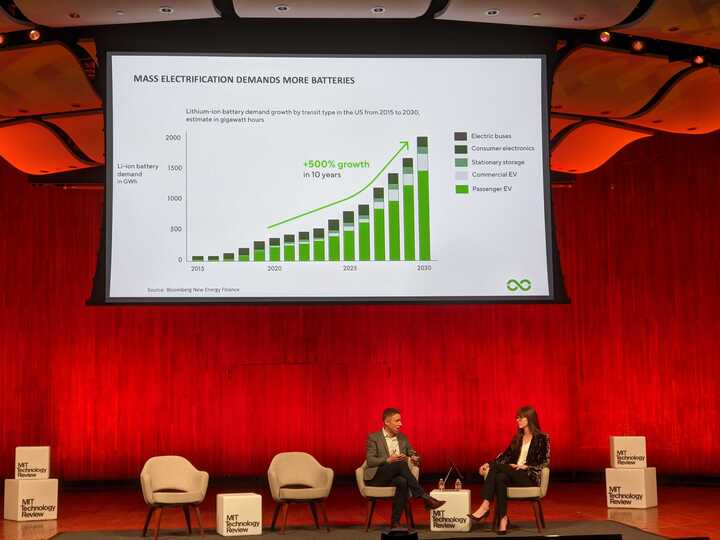Lithium ion battery demand will grow 30% annually through the next decade. Recycling will play a crucial role in keeping them available and affordable.
December 20, 2023
The electrification of vehicles has become one of the world’s most important developing trends. Automakers have collectively pledged more than $500 billion by 2030 to design and manufacture their next-generation electric vehicles.
The relative share of EVs and hybrids sold in the American market has quadrupled in three years, from around 4% of overall light-vehicle sales in 2020 to more than 16% this year. Innovations such as new battery chemistries and silicon carbide-based inverters are helping to improve the vehicle’s range and reduce its charging time. Continued improvements such as these will accelerate EV adoption even further throughout the decade.
Yet innovation also introduces challenges that must be solved for as markets change.
One of those challenges specific to electric vehicles is the issue of the battery. Batteries are still, by far, the most expensive component of an electric vehicle. They degrade in performance over time, and we don’t yet have a great system in place to recycle or reuse them.
But there is hope on the horizon. And it’s coming from one of the most important pioneers of electric vehicles.
J.B. Straubel is a familiar name among EV enthusiasts. He was one of Tesla’s (Nasdaq: TSLA) very first employees, joining in 2004 as its Chief Technology Officer and is considered one of the company’s co-founders. JB stepped down as Tesla’s CTO in 2019, though he remains on its Board of Directors.
JB has now turned his attention toward fixing the issue of battery recycling. He’s the co-founder and CEO of Redwood Materials, who’s creating a circular supply chain for recycling and refining lithium-ion batteries and their components.
Even after they’ve been heavily used and have degraded, batteries contain a lot of expensive, rare, and often foreign-sourced component materials — including lithium, nickel, cobalt, and manganese. These materials can be extracted and reused later on.
That will become extremely important. Global forecasts predict demand for lithium ion batteries will grow 30% annually and reach $400 billion by 2030.

A battery has 4 main components: the anode, the cathode, the electrolyte, and the binder/separator.
The materials required to produce those components doesn’t exist in the US; they’re almost always sourced from other countries (China is, by far, the global leader at metal refining and cathode production). The anode and the cathode alone comprise 60-80% of the battery cell’s cost and account for 15% of the entire electric vehicle’s cost.
As such, it’s becoming crucial for America to put a circular supply chain in place, where these expensive materials that are necessary for batteries to be produced can be reused again. A recycling supply chain will similarly drive down the cost of electric vehicles as a whole and also be a big win for the environment.
There are three sources of batteries being recycled today:
1) End of Life Consumer Devices: Laptops, power drills, Smartphones, etc. This is the lowest volume of recycling right now.
2) End of Life EV Batteries: After the car’s battery degrades, it can be recycled.
3) Production Scrap: Gigafactories use very high quality materials, yet much of it gets lost during production and doesn’t end up in the finished product. This is the highest volume of recycling right now.
The “End of Life” battery recycling is limited today, as EVs are still relatively new to the market and are sold in limited quantities. However, Redwood expects the volume from this source will increase significantly during the next decade, as more EVs find their way onto the roads.
Recycled batteries can get back to 95% of their “new and advertised” performance and range. Recycling facilities are quite capital intensive to build, requiring acid leeching processes to pull the desired materials out and then re-combination processes to put them back into new anodes and cathodes. In larger volumes, the processing of these materials becomes more efficient and lower cost on a per-unit basis.
The Inflation Reduction Act has paved the way for America’s renewable energy future. By offering subsidies, tax credits, and government-sponsored loans, it is accelerating investment and progress in clean energy and battery production. Redwood itself is the beneficiary of a $2 billion Department of Energy loan, which it’s using to expand its Carson City, Nevada site.
And while it’s a fast-paced race for producing the most effective and environmentally-friendly batteries, Redwood expects the winners will be lithium and nickel-based — since they’re high-performance and also the most easily recycled. There will also be opportunities for sodium ion or for iron-air batteries for long-duration storage, though these aren’t really a good fit for EVs.
Recycling is 80% less carbon-emission intensive than mining new materials. Investors should view this expanding circular supply chain as a win that will benefit multiple stakeholders.

Already a 7investing member? Log in here.